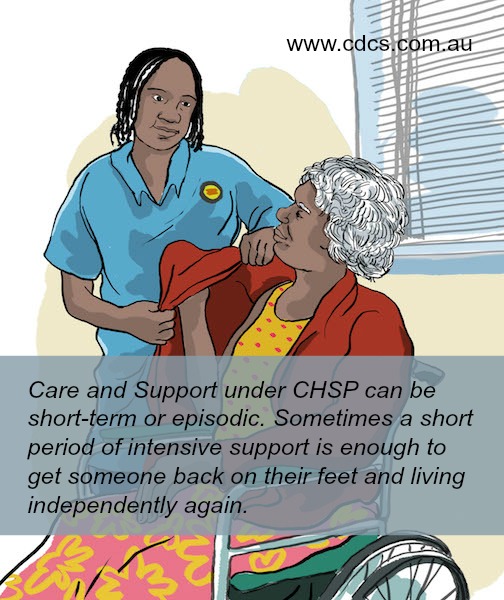By now you will have received your new contract for the continuation of the Commonwealth Home Support Programme (CHSP) funding for your organisation for a further two years. If you’ve read through the contract carefully, which you should have done, plus you have perused the updated CHSP Guidelines 2018, you’ll have noted the new requirement for completing a wellness report. But what will this look like?
The online template is now available, if you have difficulty in accessing this, contact your organisation's Grant Agreement Manager.
So how could you demonstrate a wellness and re-ablement approach?
Short-Term or Episodic Support
Let’s look at one of the easiest ways – offering short-term care and support to individuals who want, or need, time-limited support.
 Access to aged care supports should not be limited to only those who require on-going care. One aim of CHSP is that older people’s functional status is maintained or improved. It’s an important element of the program that staff need to understand and embrace. For years we have been reminding staff not to disempower clients, not to make them dependent on the help provided, but rather, support clients to do as much as they can, as well as assisting them to regain lost skills.
Access to aged care supports should not be limited to only those who require on-going care. One aim of CHSP is that older people’s functional status is maintained or improved. It’s an important element of the program that staff need to understand and embrace. For years we have been reminding staff not to disempower clients, not to make them dependent on the help provided, but rather, support clients to do as much as they can, as well as assisting them to regain lost skills.
For example, some elderly succumb to the influenza virus, or end up with pneumonia during the cold winter months, leaving them weakened and unable to complete all their activities of daily living. At this point they may be referred for services through the Commonwealth Home Support Programme. Rather than seeing this as a ‘service for life’ scenario, why not view it as a time to put in some intensive supports for a short period of time, with the aim of assisting the individual to regain their health, strength and purpose.
Sure, they may require supports again the following year around the same time if they are prone to chest infections, or they may decide that mowing the lawn is better left to the younger and fitter due to safety reasons, but if they are able to cook they don’t need to stay on the delivered meals program.
Likewise, if the client can do their own washing, vacuum their floors or drive themselves to the shops, they don’t require on-going aged care support and should be encouraged to remain independent.
Networking
Another aspect of the Commonwealth Home Support Programme is that providers must develop and maintain links with other agencies and services in a way that meets the aims of the program.
If you are networking and linking, not only with other aged care or health service providers, but also the wider community, you’ll be in a better position to support your clients to make connections with relevant support organisations. Build an awareness and knowledge of what church organisations, social clubs or activity groups are in your local area – what programs or activities do they offer? Could they help support those you care for?
In remote communities this might be the local art centre, or the Rangers Program from a nearby National Park. Building relationships with these organisations and developing links for your clients helps you demonstrate how you meet the psychological, emotional and physical well-being of consumers.
Just imagine if you have identified that one of your clients, we’ll call her Bessie, has become increasingly house-bound and less engaged with the community.
Bessie is living with her granddaughter who works at the local school, leaving Bessie alone at home all day. However, during her recent re-assessment it was identified that Bessie used to paint. The aged care coordinator contacts the local art centre and asks the manager there if Bessie can attend the centre and do some painting. The manager is agreeable and, as Bessie is already approved for transport services, her care plan is amended to include transport twice a week to the art centre. Bessie’s granddaughter picks up Bessie after she finishes at the school.
As can be seen in the above scenario, the aged care coordinator merely had to identify an activity that the client wished to participate in and link them into an existing community-run service. They didn’t need to create a whole new service type, just access what is already available. In other regions, this might be connecting a client to a book club, a tai chi course or a cultural centre.
Supporting Restorative Care Routines
What about the support your staff provide to consumers who are participating in an allied health prescribed activity to regain an aspect of their functional status. Perhaps the person has had a stroke and they are learning to walk again, with the support worker accompanying them for both safety and encouragement.
Maybe it is someone who has had a fall and broken their wrist. The support worker helps them to run through their hand strengthening exercises and encourages the person to do activities of daily living approved by the allied health professional.
Embedding wellness approaches into your support practices doesn’t need to be rocket science; you’re probably doing a lot of this already. Reflect on what you are doing across your organisation and start documenting it; when it comes to the 30th October and your report is due, this will make the job much easier!
- Aged Care Packages – what's in the box? - February 16, 2024
- 11 Ways to Make Your Progress Notes Better - September 22, 2023
- Vulnerable Clients – Who are they? - July 14, 2023



